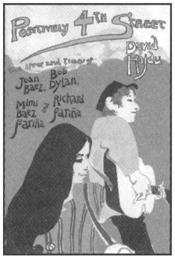Perhaps the biggest stars of the 1960’s Folk craze, Bob Dylan and Joan Baez captured audiences performing duets in addition to their successful solo careers. Their relationship is filled with ups and downs, each giving and taking from the other over the years. This tumultuous relationship may have its roots in their motivations for performing this music.

Concert Poster for Joan Baez and Bob Dylan1
At first sight, Dylan describes the first time he saw Baez singing on TV while he was still in Minnesota, “I couldn’t stop looking at her, didn’t want to blink. . . . The sight of her made me sigh. All that and then there was the voice. A voice that drove out bad spirits . . . she sang in a voice straight to God. . . . Nothing she did didn’t work.” 2 Unfortunately Joan didn’t reciprocate Dylan’s admiration for him. She recalls being unfazed by what she heard when she first saw Dylan perform in 1961 at Gerde’s Folk City (a popular venue for the Greenwich village folk music scene artists in the 1960’s).
Joan Baez is originally from Staten Island, NY. Her father Albert, co-invented the electronic microscope as well as published a Physics textbook still commonly used today. Because of her father’s work in health care and with UNESCO, the family moved many times, living in towns across the U.S, as well as in England, France, Switzerland, Spain, Canada, and Iraq. Joan became involved with a variety of social causes early in her career, especially civil rights and an advocate of non violence. “Social Justice”, Baez says, “is the true core of her life looming larger than music.”3
https://www.youtube.com/watch?v=iqaD9DAO0yQ
Joan Baez performing “Mary Hamilton” at the Newport Festival in 1960, one of her earliest performances.
In contrast, Bob Dylan was born Robert Allen Zimmerman in Hibbing, MN. Dylan began attending the University of Minnesota in 1959, only to drop out a year later and move to New York City to pay tribute to his idol, Woody Guthrie who had taken ill from Polio at the time. Dylan’s motivations for writing and performing folk music seem less rooted in social justice and more in its connection to the human spirit. At the 1965 Newport Festival Dylan walked on stage with an electric guitar in hand and the Paul Butterfield Blues Band backing him up. He was booed offstage after only three songs, at which point he returned with an acoustic guitar and a message for all the folk purists: “It’s All Over Now, Baby Blue.”4 Dylan was later quoted as saying he switched from Rock n Roll to Folk because “it was more of a serious type of thing. The songs are filled with more despair, more sadness, more triumph, more faith in the supernatural, much deeper feelings.”
Bob Dylan covering “This Land is Your Land” in Minneapolis in 1961 before moving to New York City to meet his idol, Woody Guthrie.
It seems that Baez felt a stronger connection with the movement surrounding the folk revival of the 1960’s, while Bob Dylan saw it as more of a form of political expression as much as a way to make his living and see his name in lights. Perhaps this difference was so decisive, that it ultimately caused their romantic as well as professional relationship to end?
1 Ehrenreich, B. (2001, May). Positively 4th street: The lives and times of joan baez, bob dylan, mimi baez farina and richard farina. Mother Jones, 26, 105. Retrieved from http://search.proquest.com/docview/213812109?accountid=351
2 “Joan Baez: How Sweet The Sound.” American Masters. October 14, 2009. PBS. Retrieved March 7, 2015.
3 “The Rock and Roll Hall of Fame Museum.” Bob Dylan Biography. January 1, 2015. Accessed March 9, 2015. https://rockhall.com/inductees/bob-dylan/bio/. Retrieved from Popular Culture in Britain and America, 1950-1975. http://www.rockandroll.amdigital.co.uk
2 “Joan Baez: How Sweet The Sound.” American Masters. October 14, 2009. PBS. Retrieved March 7, 2015.
